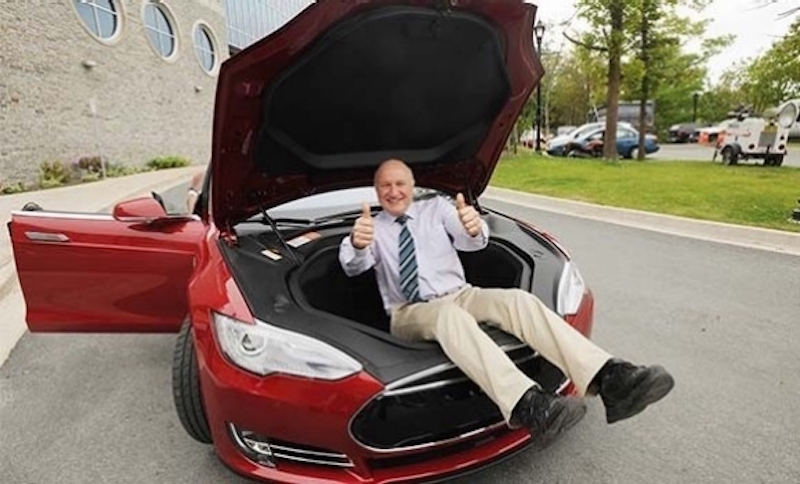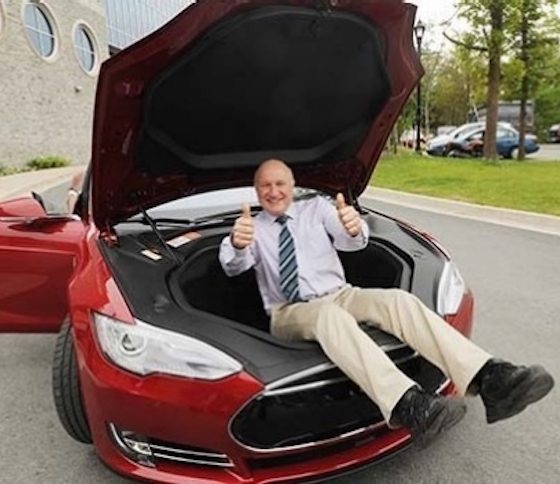

News
Tesla renews contract with Jeff Dahn’s battery team at Dalhousie University
Tesla has renewed its contract with Jeff Dahn and Dalhousie University. The partnership between Tesla and the Canadian University, which started on June 8th, 2016, held the intention of developing longer-lasting, lower-cost EV batteries.
For years, Tesla has been working with Dahn’s research team to develop new strategies for EV battery development and longevity. One of the most notable was an electrolyte solvent, which Dahn’s team submitted a patent for on behalf of Tesla in the company’s search for a 1 million mile-capable battery cell.
It appears that the partnership has been extended, based on a new announcement from the school.
On Monday, January 18th, Dalhousie University published a press release that announced the addition of two new scientists who will act as the school’s newest research chairs in the development of electric vehicle batteries and technology. Dr. Chongyin Yang and Dr. Michael Metzger, two established scientsts in the battery industry, will join Dalhousie’s exclusive partnership with Tesla to develop world-class electric vehicle batteries.
Dalhousie University detailed the addition of Dr. Yang and Dr. Metzger:
“Dr. Chongyin Yang is the Tesla Canada Research Chair and has been working on materials and devices for energy conversion and storage for 12 years. Prior to coming to Dalhousie University, Dr. Yang was an assistant research scientist in the Department of Biomolecular Engineering at the University of Maryland, where he led research projects on material and device development for high energy aqueous lithium-ion batteries.
Dr. Michael Metzger is the Herzberg-Dahn Chair and received a diploma from the Technical University of Munich (TUM), the top-ranked university in Germany and the European Union. While completing his graduate studies, Dr. Metzger developed innovative methods to study the lifetime and aging of lithium-ion batteries in close collaboration with BASF and BMW. He has also worked in the Silicon Valley tech industry as a research engineer for Robert Bosch, the largest supplier for the automotive industry.”
Dahn commented on the addition of both of the new Doctors, stating that he was extremely pleased with the announcement and looks forward to the contributions they will make. “Our goal is to continue to help Tesla develop better advanced batteries for its products. Dr. Yang and Dr. Metzger bring new ideas, new methods, and new expertise as well as a full commitment to electric transportation and renewable energy to the partnership,” Dahn said.
Tesla battery researcher Jeff Dahn’s tests hint at li-ion cells breaking the 2M-mile barrier
Additionally, Dalhousie announced that their partnership with Tesla has been extended until at least 2026.
“The initial research agreement between Dalhousie University and Tesla was signed in June 2015. This collaboration is a first between the leading American electric vehicle company and a Canadian university. Work officially began with Tesla in 2016, and the partnership has been renewed until at least 2026.”
Tesla also commented on Yang and Metzger’s new roles, which will help the company in their pursuit of longer lasting and more powerful EV battery cells. ”
“We are thrilled to be extending and expanding our work with Dalhousie and Jeff Dahn with the addition of Chongyin and Michael. We look forward to their important contributions in battery technology to help achieve our mission,” the automaker said.
H/t: Electrek

News
Tesla FSD fleet is nearing 7 billion total miles, including 2.5 billion city miles
As can be seen on Tesla’s official FSD webpage, vehicles equipped with the system have now navigated over 6.99 billion miles.

Tesla’s Full Self-Driving (Supervised) fleet is closing in on almost 7 billion total miles driven, as per data posted by the company on its official FSD webpage.
These figures hint at the massive scale of data fueling Tesla’s rapid FSD improvements, which have been quite notable as of late.
FSD mileage milestones
As can be seen on Tesla’s official FSD webpage, vehicles equipped with the system have now navigated over 6.99 billion miles. Tesla owner and avid FSD tester Whole Mars Catalog also shared a screenshot indicating that from the nearly 7 billion miles traveled by the FSD fleet, more than 2.5 billion miles were driven inside cities.
City miles are particularly valuable for complex urban scenarios like unprotected turns, pedestrian interactions, and traffic lights. This is also the difference-maker for FSD, as only complex solutions, such as Waymo’s self-driving taxis, operate similarly on inner-city streets. And even then, incidents such as the San Francisco blackouts have proven challenging for sensor-rich vehicles like Waymos.
Tesla’s data edge
Tesla has a number of advantages in the autonomous vehicle sector, one of which is the size of its fleet and the number of vehicles training FSD on real-world roads. Tesla’s nearly 7 billion FSD miles then allow the company to roll out updates that make its vehicles behave like they are being driven by experienced drivers, even if they are operating on their own.
So notable are Tesla’s improvements to FSD that NVIDIA Director of Robotics Jim Fan, after experiencing FSD v14, noted that the system is the first AI that passes what he described as a “Physical Turing Test.”
“Despite knowing exactly how robot learning works, I still find it magical watching the steering wheel turn by itself. First it feels surreal, next it becomes routine. Then, like the smartphone, taking it away actively hurts. This is how humanity gets rewired and glued to god-like technologies,” Fan wrote in a post on X.
News
Tesla starts showing how FSD will change lives in Europe
Local officials tested the system on narrow country roads and were impressed by FSD’s smooth, human-like driving, with some calling the service a game-changer for everyday life in areas that are far from urban centers.

Tesla has launched Europe’s first public shuttle service using Full Self-Driving (Supervised) in the rural Eifelkreis Bitburg-Prüm region of Germany, demonstrating how the technology can restore independence and mobility for people who struggle with limited transport options.
Local officials tested the system on narrow country roads and were impressed by FSD’s smooth, human-like driving, with some calling the service a game-changer for everyday life in areas that are far from urban centers.
Officials see real impact on rural residents
Arzfeld Mayor Johannes Kuhl and District Administrator Andreas Kruppert personally tested the Tesla shuttle service. This allowed them to see just how well FSD navigated winding lanes and rural roads confidently. Kruppert said, “Autonomous driving sounds like science fiction to many, but we simply see here that it works totally well in rural regions too.” Kuhl, for his part, also noted that FSD “feels like a very experienced driver.”
The pilot complements the area’s “Citizen Bus” program, which provides on-demand rides for elderly residents who can no longer drive themselves. Tesla Europe shared a video of a demonstration of the service, highlighting how FSD gives people their freedom back, even in places where public transport is not as prevalent.
What the Ministry for Economic Affairs and Transport says
Rhineland-Palatinate’s Minister Daniela Schmitt supported the project, praising the collaboration that made this “first of its kind in Europe” possible. As per the ministry, the rural rollout for the service shows FSD’s potential beyond major cities, and it delivers tangible benefits like grocery runs, doctor visits, and social connections for isolated residents.
“Reliable and flexible mobility is especially vital in rural areas. With the launch of a shuttle service using self-driving vehicles (FSD supervised) by Tesla in the Eifelkreis Bitburg-Prüm, an innovative pilot project is now getting underway that complements local community bus services. It is the first project of its kind in Europe.
“The result is a real gain for rural mobility: greater accessibility, more flexibility and tangible benefits for everyday life. A strong signal for innovation, cooperation and future-oriented mobility beyond urban centers,” the ministry wrote in a LinkedIn post.
News
Tesla China quietly posts Robotaxi-related job listing
Tesla China is currently seeking a Low Voltage Electrical Engineer to work on circuit board design for the company’s autonomous vehicles.

Tesla has posted a new job listing in Shanghai explicitly tied to its Robotaxi program, fueling speculation that the company is preparing to launch its dedicated autonomous ride-hailing service in China.
As noted in the listing, Tesla China is currently seeking a Low Voltage Electrical Engineer to work on circuit board design for the company’s autonomous vehicles.
Robotaxi-specific role
The listing, which was shared on social media platform X by industry watcher @tslaming, suggested that Tesla China is looking to fill the role urgently. The job listing itself specifically mentions that the person hired for the role will be working on the Low Voltage Hardware team, which would design the circuit boards that would serve as the nervous system of the Robotaxi.
Key tasks for the role, as indicated in the job listing, include collaboration with PCB layout, firmware, mechanical, program management, and validation teams, among other responsibilities. The role is based in Shanghai.
China Robotaxi launch
China represents a massive potential market for robotaxis, with its dense urban centers and supportive policies in select cities. Tesla has limited permission to roll out FSD in the country, though despite this, its vehicles have been hailed as among the best in the market when it comes to autonomous features. So far, at least, it appears that China supports Tesla’s FSD and Robotaxi rollout.
This was hinted at in November, when Tesla brought the Cybercab to the 8th China International Import Expo (CIIE) in Shanghai, marking the first time that the autonomous two-seater was brought to the Asia-Pacific region. The vehicle, despite not having a release date in China, received a significant amount of interest among the event’s attendees.








